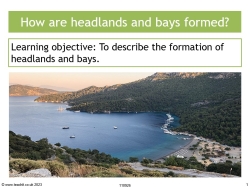How are headlands and bays formed?

Use this complete lesson to introduce students to how and why headlands and bays are formed, including the coastal processes and geological factors that lead to these coastal features emerging.
What’s included?
This teaching resource includes a complete lesson PowerPoint with activities, instructions and answers included, plus a printable worksheet for completing the activities.
How to use this resource
Use the lesson starter to recap key vocabulary words (hydraulic action, abrasion, attrition, solution and fetch) before introducing students to bays and headlands and summarising key learning points with a fill-in-the-blank activity.
The field sketching and diagram drawing activities allow students to learn about the coastal features that emerge as a result of concordant and discordant coastlines, and identify the erosional landforms that result from the processes of coastal erosion.
‘Write like a geographer’ and storyboard activities provide a great opportunity to consolidate and recap learning, to ensure students understand how and why bays and headlands form along certain stretches of coastline.
Looking for more like this?
For more like this, explore the full Coasts resource collection, including teaching materials on case studies, landforms, coastal management and more.
Completed fill-the-blanks paragraph on the formation of headlands and bays:
Headlands and bays are two examples of coastal landforms. They are formed when the sea attacks a section of coastline which has both more and less resistant rock. Rocks such as limestone are more resistant whereas clay is less resistant. This can be seen in locations such as the Jurassic coastline.
A headland is a section of land which juts out into the sea. The geology here is more resistant and erodes more slowly than the land around it. Features such as arches and caves form in headlands.
A bay is an area of land that has eroded away more quickly because it is less resistant rock. Bays often have beaches in them as the material is deposited.
The formation of headlands and bays can take millions of years.
